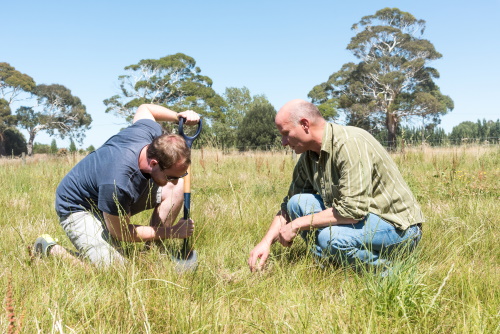13 July 2021

PhD candidate Connor Watson (left) and Dr Mark Hurst search for grass grubs in a field
Why do some strains of two bacteria cause disease in grass grub, while others don’t? This was a question we set out to answer in our project “Enhancing microbial-based biological control” (Project 5).
The larvae of the endemic New Zealand grass grub Costelytra giveni is a major pasture pest. Some strains of Serratia entomophila and S. proteamaculans can cause pathogenic diseases that may help to control this pest.
Biopesticides based on several strains are either in the market or in development, but there is much we don’t know. This project shed light on several aspects.
The diseases these bacteria cause appear to be to be encoded by plasmids (extrachromosomal DNA) that can move between strains. Non-pathogenic strains don’t have these plasmids. But do non-pathogenic strains always remain non-pathogenic, or can plasmids move easily?
We wanted to know how the interaction between strains with and without plasmids influences disease. This also has implications for many other systems encoded by plasmid-based genes, including human diseases.
Three hypotheses
The project centred on three hypotheses:
- The plasmid is clonal, harbouring different virulence regions
- The grass-grub-specific species S. entomophilia is conserved in its genome structure and on a path to commensalism
- The presence of plasmid-free strains decreases the effectiveness of biopesticides.
We set out to understand how many types of disease-encoding plasmids there are and how they evolved. We found a lot of variation, showing how plasmids acquired and lost genes from other bacteria to end up with several disease-encoding types, based on a common Serratia-associated transmissible adaptive mega-plasmid.
Genome analysis confirmed that S. entomophila has a more conserved, stable genome structure than S. proteamaculans, with fewer examples of horizontal gene transfer. It contained a conserved plasmid, pADAP, with a diverse array of pADAP variants identified in S. proteamaculans strains. The pADAP plasmid backbone is conserved (clonal in nature), but has acquired accessory determinants.
The next question was, does it matter which strain hosts these plasmids? Yes, it does. Introducing a plasmid to an alternative strain alters the bacterium’s ability to produce accessory virulence determinants such as proteolytic enzymes.
Our research showed that particular strains retain Serratia plasmids and plasmid-free variants have likely always been plasmid-free. However, we saw plasmid transfer occur in the grass grub gut, in high-density bacterial situations. So while plasmids may be able to move between cells, there are strong constraints on jumping between bacteria.
Finally we looked at what happens to plasmid-containing and plasmid-free strains in competition. In cultures, non-plasmid strains can outcompete the plasmid-containing strains. Transcriptomics identified the upregulation of key genes that enable the plasmid-free strains to outcompete plasmid-bearing strains during rapid growth.
The finding that in laboratory and pot trials the presence of plasmid-free strains reduces the field effectiveness of applied bacteria for grass grub control underpins the basis of this project and means microbes already in the soil may affect biopesticide effectiveness.
